Cool-Season Annual Grasses
These grasses can be used on fallow crop ground, or over areas planted to warm-season grasses to provide high quality forage during the winter. Just as with warm-season annual grasses, these grasses tend to be expensive, so their use should be limited.
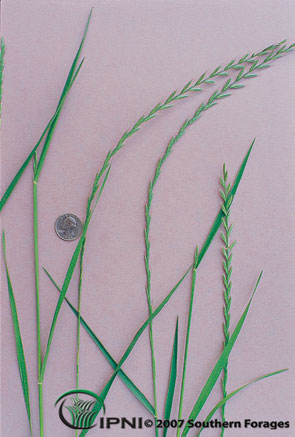
Annual Ryegrass (Lolium multiflorum)
Origin: Europe
Description: Annual bunchgrass. Shiny, dark green smooth leaves. Grows 2 to 3 feet tall.
Major Uses: Mainly pasture although sometimes used for hay or silage.
Establishment: Seeding rate is 10 to 15 lb/A in mixtures, or 20 to 30 lb/A alone. September or early October are generally the best months to plant. Natural reseeding is common.
Fertilization: Responsive to nitrogen. Tolerant of moderate soil acidity.
Production: In high rainfall areas of the Gulf Coast, high production can be expected through the winter from November to May. Farther north, most of the production is concentrated from late February or March through May. Under favorable conditions, high forage production and excellent animal gains can be achieved.
Management: Ryegrass may be seeded alone in the Gulf Coast area but farther north it is usually seeded with a small grain (rye, wheat or oats) and/or a clover. Ryegrass will tolerate close continuous grazing.
© Southern Forages. International Plant Nutrition Institute.
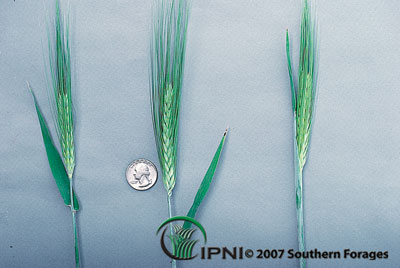
Rye (Secale cereale)
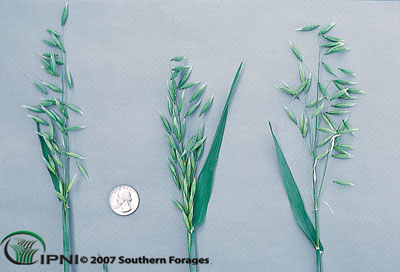
Oats (Avena sativa)
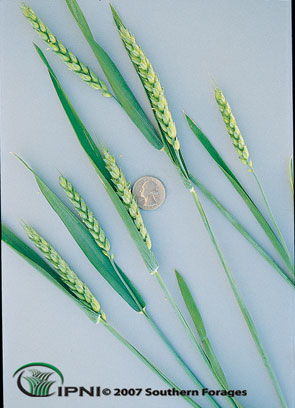
Origin: Iraq, Turkey, Europe
Description: Annual bunchgrasses 2 to 4 feet tall.
Major Uses: Rye-pasture; Barley, Wheat, Oats – pasture hay, silage; Triticale – hay, silage.
Establishment: Seed are usually planted in September or October. In mixtures, 60 to 90 lb/A are recommended, but 90 to 120 lb/A if planted alone.
Fertilization: All the small grains are highly responsive to nitrogen and require adequate amounts of phosphorus and potassium.
Production: November to December and February to May.
Management: Stocking rate should be adequate to utilize forage and to allow new leaf growth. An annual legume such as arrowleaf clover which produces growth in late spring can be planted as a companion crop to extend the production season and maintain spring forage quality. If cut for hay or silage, the harvest should be made in the boot to early heading stage.
© Southern Forages. International Plant Nutrition Institute.
Cool-Season Perennial Grasses
Grasses in this category tend to predominate forage programs in Tennessee. Their long growing seasons and high quality make them desirable forage crops. Their ability to survive summer droughts vary, so stand life can vary tremendously between these grasses.
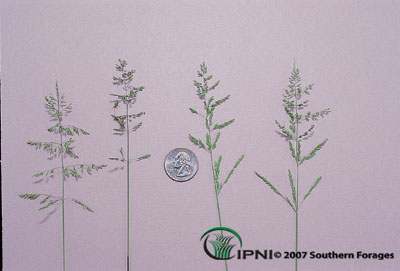
Kentucky Bluegrass (Poa pratensis)
Origin: Europe
Description: Perennial. Rhizomes produce a dense sod. Grows 1 to 3 feet tall.
Major Uses: Pasture, limited use for hay. High nutritive value.
Establishment: Seed are planted at 10 to 15 lb/A in August-September, or sometimes in February-March.
Fertilization: Kentucky bluegrass will survive under low fertility, but is not highly productive unless well fertilized or grown with a legume.
Production: April-October, limited in July and August.
Management: Kentucky bluegrass tolerates close and frequent grazing better than many grasses. Grazing to a height of 1 to 2 inches favors productivity and maintains a dense sod. Bluegrass pasture is much more productive when clover is grown with it.
© Southern Forages. International Plant Nutrition Institute.
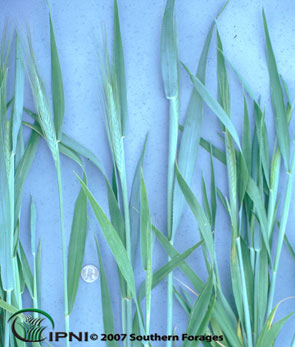
Matuagrass (Bromus willdenowii)
Origin: Argentina
Description: Short-lived perennial or natural reseeding annual bunchgrass. Grows 2 to 4 feet tall.
Major Uses: Pasture. High nutritive quality. Good winter production.
Establishment: Seed are planted in September at 25 to 30 lb/A, not deeper than 1/4-inch. Seedling vigor and growth are exceptional.
Fertilization: High fertility requirement.
Production: November to May or June.
Management: Will not survive under close continuous grazing. Must be rotationally stocked to maintain stands.
© Southern Forages. International Plant Nutrition Institute.
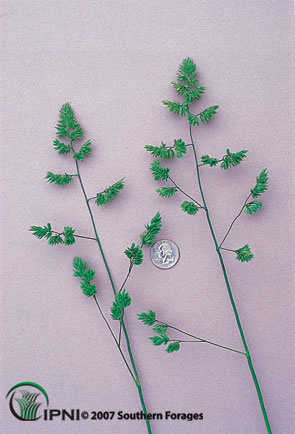
Orchardgrass (Dactylis glomerata)
Origin: Europe
Description: Perennial bunchgrass. Grows 2 to 3 feet tall.
Major Uses: Pasture, hay. Forage quality is high under good management.
Establishment: Seed should be planted in September at 15 to 20 lb/A, preferably with a legume. Plantings are sometimes made in early spring.
Fertilization: Requires higher fertility than tall fescue. Responds well to nitrogen.
Production: March-June or July; production during September-November is much less than tall fescue.
Management: Orchardgrass requires better management than endophyte-infected tall fescue. Close continuous grazing will weaken stands. Moderate stocking is best. Orchardgrass is less competitive than tall fescue, so adapted legumes persist better in association with it. The first hay harvest of the season should be in the boot to early bloom stage, with subsequent harvests as growth permits.
© Southern Forages. International Plant Nutrition Institute.
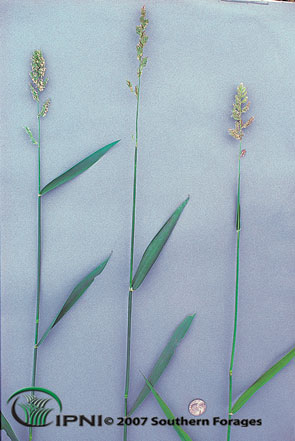
Reed Canarygrass (Phalaris arundinacea)
Origin: Europe
Description: Coarse, sod-forming perennial with short rhizomes, 2 to 6 feet tall. Deep-rooted.
Major Uses: Pasture, hay, silage.
Establishment: Seedling vigor is poor so establishment is slow. A seeding rate of 5 to 8 lb/A planted during April-May in northern U.S. or August-September in Tennessee should give satisfactory stands.
Fertilization: Highly responsive to nitrogen.
Production: April-September
Management: Rotational stocking.
© Southern Forages. International Plant Nutrition Institute.
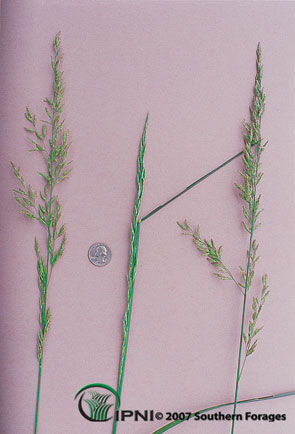
Tall Fescue (Festuca arundinacea)
Origin: Europe
Description: Perennial long-lived bunchgrass with short rhizomes. Shiny, dark green, ribbed leaves. Deep rooted. Grows 2 to 4 feet tall.
Major Uses: Pasture, hay, erosion control. High forage quality if free of fungal endophyte.
Establishment: Seed are drilled at 15 to 20 lb/A or broadcast at 20 to 25 lb/A in September or October.
Fertilization: Tolerant of low fertility and acid soils but responds well to fertilization.
Production: September-December, March-June.
Management: Tall fescue, if endophyte-infected, will tolerate grazing abuse better than most grasses. Endophyte-free tall fescue should not be grazed closer than 3 inches and should especially not be overgrazed during summer. Ladino or red clovers or alfalfa can be grown with tall fescue. The first harvest of hay should be cut in the late boot stage for high quality. Subsequent harvests can be made as growth permits.
© Southern Forages. International Plant Nutrition Institute.

Timothy (Phleum pratense)
Origin: Northern Europe
Description: Perennial bunchgrass. Grows 2 to 4 feet tall.
Major Uses: Primarily as a hay plant but also used for pasture. It is popular as a hay crop for horses although other grasses are equally satisfactory.
Establishment: Seed are planted at 6 to 8 lb/A with a clover, alfalfa or trefoil in August or September, or sometimes in early spring.
Fertilization: Tolerant of low fertility but responds well to fertilization.
Production: April-October with low production in August-October.
Management: Hay should be cut at the boot to early bloom stage to obtain best quality. Late-cut timothy hay is of low quality.
© Southern Forages. International Plant Nutrition Institute.
Warm-Season Annual Grasses
These grasses can provide grazing and hay during a two or three month period during the summer. Annuals tend to be more expensive than perennials, so the profitable use of these grasses is limited.
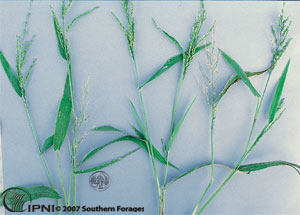
Browntop Millet (Panicum ramosum)
Origin: Southeast Asia
Description: Annual. Erect, 2 to 3 feet tall, leafy, fine-stemmed.
Major Uses: Pasture, hay.
Establishment: Seed drilled at 15 to 20 lb/A or broadcast at 25 to 30 lb/A in May-August.
Fertilization: Responsive to nitrogen, very tolerant of soil acidity.
Production: June-August. Much less productive than pearl millet or sorghum-sudan hybrids.
Management: Hay should be cut at heading.
© Southern Forages. International Plant Nutrition Institute.
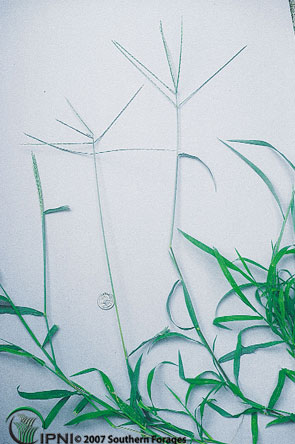
Crabgrass (Digitaria sanguinalis)
Origin: Southern Africa
Description: Annual, creeping-type growth with long runners, very leafy. Grows 2 to 4 feet tall.
Major Uses: While considered a weed in many farming situations, crabgrass is useful for pasture and hay. Nutritive quality is superior to warm season perennial grasses
Establishment: Seed. Reseeds well.
Fertilization: Crabgrass is highly responsive to nitrogen fertilizer.
Production: May-September.
Management: With adequate fertilization, crabgrass will support good stocking rates. Volunteers after winter annuals.
© Southern Forages. International Plant Nutrition Institute.
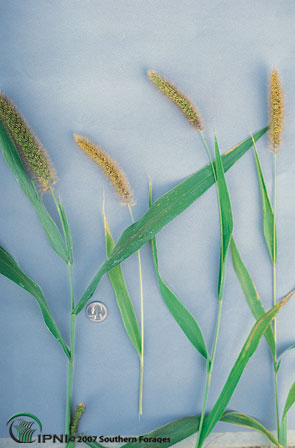
Foxtail Millet (Setaria italica)
Origin: Southern Asia
Description: Annual. Erect, 3 to 4 feet tall, leafy, fine-stemmed.
Major Uses: Hay. Once was widely grown, but infrequently at present.
Establishment: Seed can be drilled at 15 to 20 lb/A or broadcast at 20 to 30 lb/A in May-July.
Fertilization: Responds to nitrogen fertilization.
Production: Most varieties are ready to be harvested in 60 to 70 days. Less productive than pearl millet or sorghum-sudan hybrids.
Management: Should be cut for hay near seedhead emergence. Not recommended for horse hay because of a toxin which can cause kidney and joint problems.
© Southern Forages. International Plant Nutrition Institute.
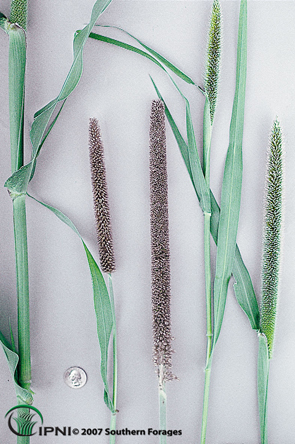
Pearl Millet (Pennisetum glaucum)
Origin: North Central Africa
Description: Annual. Erect, 3 to 8 feet tall, leafy.
Major Uses: Pasture, silage. Difficult to make hay because of thick stems. High nutritive quality if harvested at immature stage. Nitrate accumulation can cause toxicity under some circumstances.
Establishment: Seed are drilled at 12 to 15 lb/A or broadcast at 25 to 30 lb/A in April-June.
Fertilization: Much more tolerant of soil acidity than sorghum. Responsive to nitrogen.
Production: Very productive over a short season, generally from June-August.
Management: Requires high stocking rate, preferably with rotational stocking. Stems may need to be mowed after grazing. Should be cut for hay when plants are 30 to 40 inches tall.
© Southern Forages. International Plant Nutrition Institute.
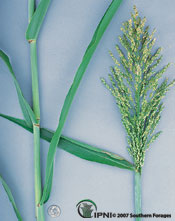
Sorghum-Sudangrass Hybrids and Sudangrass (Sorghum bicolor)
Origin: Northeast Africa
Description: Annual. Erect, 4 to 8 feet tall, leafy.
Major Uses: Pasture, hay, silage. High quality if harvested at immature stage. Difficult to make hay because of thick stems. Nitrate accumulation or prussic acid can cause toxicity under some circumstances.
Establishment: Seed are drilled at 20 to 25 lb/A or broadcast at 30 to 35 lb/A in May or June.
Fertilization: Very responsive to nitrogen. Needs lime on highly acid soils.
Production: Quite productive over a short season. June-September.
Management: Requires high stocking rate, preferably grazed rotationally, to utilize rapid growth and maintain high quality. Thin-stemmed varieties recover more rapidly after cutting or grazing than thick-stemmed varieties. Stems may need to be mowed after grazing. Hay and silage should be cut when plants are 30 to 40 inches tall.
© Southern Forages. International Plant Nutrition Institute.
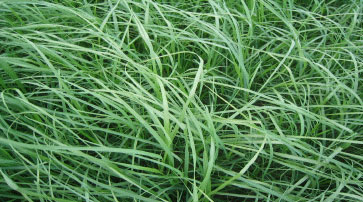
Teff Grass (Eragrostis tef)
Origin: Africa
Description: Fine-stemmed, vigorous, warm season annual grass
Major Uses: Primarily as a hay plant but also used for pasture.
Establishment: Requires a frost free growing season, so seed must be planted in the spring after the risk of frost has past.
Production: April-October.
Management: Cut before maturity for optimal forage quality (approx. 45-50 days after planting) seed head should not be present. Leave 3-4 inch stubble height for proper regrowth.
Other: It can produce high quality hay in a relatively short growing season. Nutritive value of Teff is comparable to Timothy, making it an excellent forage for horses and other livestock. Palatability and animal acceptance has been reported to be very good by horse owners. Very few disease and pest problems have been observed.
© Southern Forages. International Plant Nutrition Institute.
Warm-Season Perennial Grasses
These grasses tend to be more drought tolerant plants, that produce forage between April and October. Little to no forage is produced outside of these dates. These forages have the potential to provide hay and grazing during the summer, when cool-season grasses are less productive due to drought and heat.
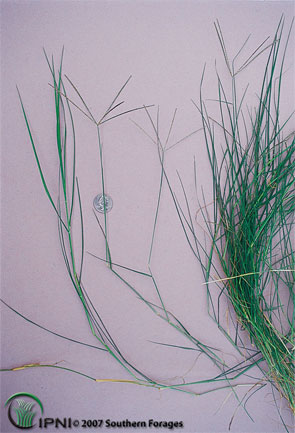
Bermudagrass (Cynodon dactylon)
Origin: Southeastern Africa
Description: Perennial. Spreads by rhizomes, stolons and (in some types) by seed. Hybrids are deep-rooted. Grows 15 to 24 inches tall.
Major Uses: Pasture, hay.
Establishment: Hulled seed of common bermudagrass or other seed-propagated varieties or types should be planted at 5 to 10 lb/A in spring. Hybrids are planted in April- May with sprigs at 10 bu/A in rows or broadcast at 25 to 40 bu/A and covered.
Production: April-September.
Fertilization: Highly responsive to nitrogen. Potassium is important for survival and production.
Management: Hay should be harvested at about 4 week intervals. With good management, hay yields of 5 to 7 tons/A can be obtained. Should be closely grazed to maintain quality. Annual clovers, small grains, and ryegrass should be overseeded in autumn if winter-spring production is desired.
© Southern Forages. International Plant Nutrition Institute.
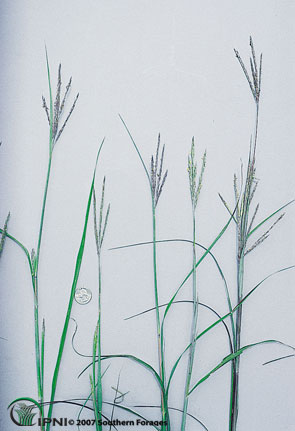
Big Bluestem (Andropogon gerardii)
Origin: Great Plains and eastern USA.
Description: Perennial bunchgrass, sometimes having rhizomes. Deep rooted. Grows 3 to 6 feet tall. More drought-tolerant than most warm season grasses.
Major Uses: Pasture, hay. It remains palatable and nutritious over a longer time than switchgrass.
Establishment: Slow seedling establishment. Seed should be planted at 5 to 10 lb/A pure live seed in April-May.
Fertilization: Responsive to nitrogen.
Production: June-August.
Management: Will not tolerate close,continuous stocking.
© Southern Forages. International Plant Nutrition Institute.
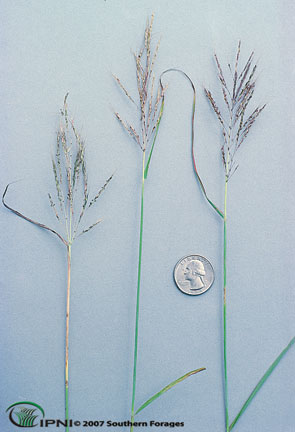
Caucasian Bluestem (Bothriocloa caucasica)
Origin: Former USSR
Description: Perennial bunchgrass, leafy with fine stems, deep-rooted and drought-tolerant. Grows 2 to 4 feet tall.
Major Uses: Pasture, hay. Less palatable than big bluestem.
Establishment: Seed planted at 2 to 3 lb/A in May or June.
Fertilization: Responsive to nitrogen.
Production: Late May-August.
Management: Stock heavily in early summer when quality is best. Nutritive quality declines with maturity.
© Southern Forages. International Plant Nutrition Institute.
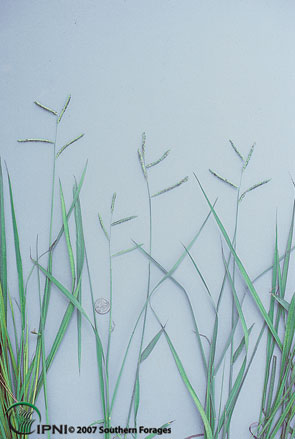
Dallisgrass (Paspalum dilatatum)
Origin: Argentina, Uruguay, Brazil.
Description: Perennial bunchgrass, short rhizomes. Grows 10 to 20 inches tall. Very leafy.
Major Uses: Pasture, but can be harvested for hay. Better nutritive quality than bermudagrass.
Establishment: Seed germination is low and establishment is slow. About 10 to 15 lb/A of pure live seed should be broadcast planted in March or April.
Fertilization: Moderately responsive to nitrogen.
Production: April-October.
Management: Best grown with ladino or red clover. Seed heads can be clipped to eliminate Ergot problem if it develops.
© Southern Forages. International Plant Nutrition Institute.
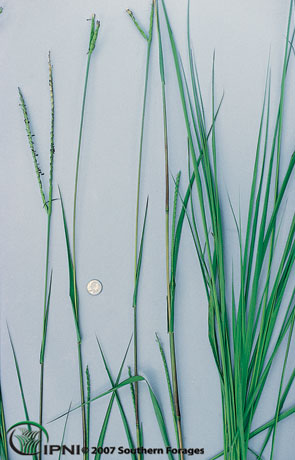
Eastern Gammagrass (Tripsacum dactyloides)
Origin: Eastern Great Plains and eastern USA.
Description: Perennial bunchgrass, short rhizomes, 3 to 8 feet tall.
Major Uses: Pasture, hay. Good nutritive quality. Little is planted.
Establishment: Commercial seed production is a problem and establishment is difficult.
Fertilization: High fertility.
Production: June-August.
Management: Rotational stocking.
© Southern Forages. International Plant Nutrition Institute.
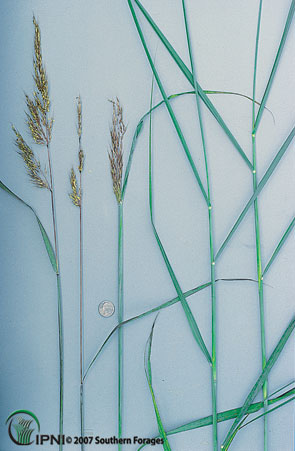
Indiangrass (Sorghastrum nutans)
Origin: Native to tall grass prairie of eastern Great Plains and eastern USA
Description: Perennial bunchgrass. Spreads by rhizomes and seed. Deep rooted. Grows 3 to 6 feet tall. The yellow panicles are 6 to 12 inches long.
Major Uses: Pasture, but can be harvested for hay. Nutritive quality is generally better than most other warm season perennial grasses.
Establishment: Seedlings grow slowly and compete poorly with weeds. Seed should be planted at 6 to 10 lb/A pure live seed during April-May.
Fertilization: Nitrogen is the most important fertilizer element. Response to other nutrients is generally lower than for cool season grasses.
Production: Late June-September.
Management: Rotational stocking is essential if grazed below 6 inches. Can be continuously stocked if stubble is maintained between 10 to 16 inches. Very light grazing after September 1.
© Southern Forages. International Plant Nutrition Institute.
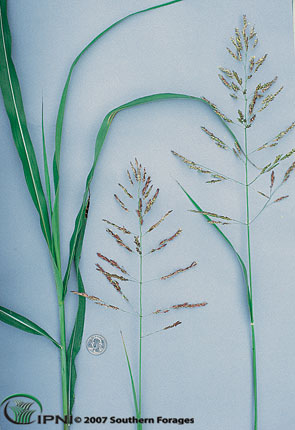
Johnsongrass (Sorghum halepense)
Origin: Mediterranean region
Description: Perennial. Erect, 3 to 6 feet tall. Spreads by rhizomes and seed. Drought-tolerant. Can be a serious pest in crops.
Major Uses: Best used for hay but can be grazed with good management.
Establishment: Seed are planted in April at 20 to 30 lb/A broadcast or 10 to 15 lb/A drilled.
Fertilization: Responds well to nitrogen.
Production: May-September.
Management: Hay should be harvested at heading. If used for pasture, rotational stocking is needed to maintain stands. Close continuous grazing will reduce vigor and stands. Prussic acid potential.
© Southern Forages. International Plant Nutrition Institute.
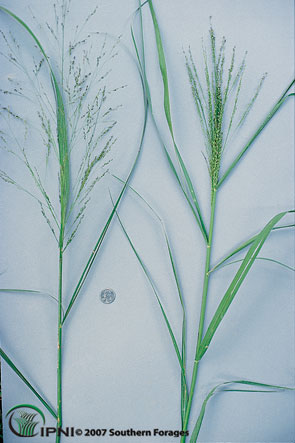
Switchgrass (Panicum virgatum)
Origin: Native to Great Plains and most of eastern USA.
Description: Perennial bunchgrass. Spreads by rhizomes and seed. Deep-rooted. Grows 3 to 7 feet tall.
Major Uses: Pasture, hay. Develops stems several weeks earlier than other warm season grasses so may become stemmy and unpalatable early in summer. Improved varieties have higher yields and nutritive quality.
Establishment: Slow seedling establishment. Seed should be planted at 5 to 6 lb/A pure live seed in April-May.
Fertilization: Very responsive to nitrogen.
Production: Late May-July.
Management: Should be stocked heavily and rotationally stocked with 4 to 6 weeks rest between grazings to maintain quality and stands.
© Southern Forages. International Plant Nutrition Institute.
Cool-Season Annual Legumes
These Legumes make most of their growth in the winter and spring. These species may be seeded in the fall to provide a higher quality late winter/spring pasture.
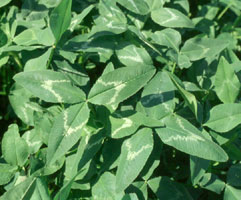
Arrowleaf Clover (Trifolium vesiculosum)
Origin: Mediterranean region.
Description: Late season winter annual. Long, branching, hollow stems 2 to 4 feet long. The non-hairy arrow-shaped leaves generally have a large white “V” mark. The predominately white, but pink and purple-tinged flower heads are large, often 3 inches long. Flowering and seed production occur over a long period in late spring and summer. The rough brown seed are about twice the size of ladino clover seed and over 70 percent have very hard seed coats, requiring scarification for satisfactory germination.
Major Uses: Pasture, hay. Forage quality is high with digestibility generally superior to crimson clover at all stages of maturity. Bloat is rarely a problem.
Establishment: Scarified seed are planted broadcast at 5 to 10 lb/A in September to early November. Requires a special seed inoculant. Seed will germinate at lower temperatures than crimson clover. Reseeds easily.
Fertilization: Arrowleaf is not very tolerant of soil acidity and low fertility. Optimum pH range if 5.8 to 6.5.
Production: March-early July.
Management: Arrowleaf will continue to develop new leaves and remain productive longer in the spring when grazed to a height of 2 to 4 inches than where large amounts of forage accumulate. Where hay is desired, clover should be grazed until early to mid-April, then harvested at early to mid-bloom in May. No regrowth can be expected after cutting hay.
© Southern Forages. International Plant Nutrition Institute.
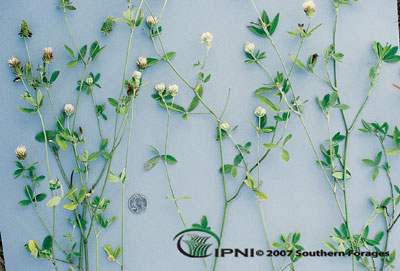
Berseem Clover (Trifolium alexandrinum)
Origin: Mediterranean region.
Description: Winter annual, resembles alfalfa, hollow stems grow erect to a height of 2 feet or more. White flowers form small heads.
Major Uses: Pasture, hay. High quality, does not cause bloat.
Establishment: Seed are planted broadcast at 20 lb/A or drilled at 10 to 15 lb/A in September.
Fertilization: Best on loam soils of pH 6 or above. Requires high fertility including boron.
Production: November-December and March-June.
Management: Grazing should begin when 10 inches tall and the stubble maintained at 3 to 4 inches to encourage new leaf production. Rotational stocking is most successful. The winter-hardy berseem variety produces hard seed and will often reseed.
© Southern Forages. International Plant Nutrition Institute.
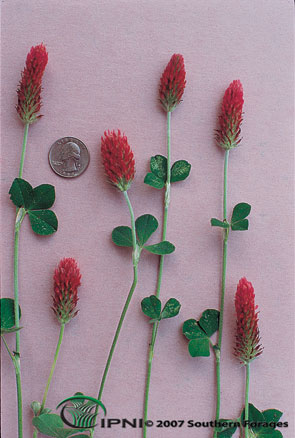
Crimson Clover (Trifolium incarnatum)
Origin: Mediterranean region.
Description: Winter annual. Plants have dark green leaves densely covered with hairs, and grow to a height of 1 to 3 feet. Brilliant crimson flowers, long heads, maturing from bottom to top. Yellow rounded seed about 2.5 times the size of arrowleaf clover seed. Combine-harvested seed do not need scarification.
Major Uses: Pasture, hay, green manure crop, roadside beautification. Will produce more forage at low temperatures than other clovers.
Establishment: Seed are broadcast at 20 to 30 lb/A in late August-October.
Fertilization: Fairly tolerant of soil acidity.
Production: November, March-April.
Management: Can be grazed throughout winter but if hay is desired, cattle must be removed by mid-March.
© Southern Forages. International Plant Nutrition Institute.
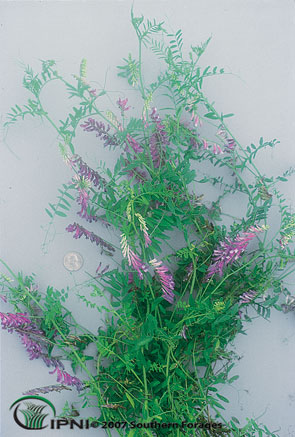
Hairy Vetch (Vicia villosa)
Origin: Mediterranean region.
Description: Viney winter annuals with stems 2 to 4 feet in length. White, purple, or pale yellow flowers are borne in clusters.
Major Uses: Pasture, hay, silage (with small grain companion), green manure.
Establishment: Hairy and bigflower vetch seed are broadcast at 20 to 25 lb/A and common vetch at 30 to 40 lb/A in September-October.
Fertilization: Vetches are tolerant of soil acidity but have a relatively high phosphorus requirement.
Production: March-May
Management: Grazing should not begin until plants are at least 6 inches tall. Close grazing will destroy buds needed for regrowth. Vetch should be cut for hay in the early bloom stage. A small grain seeded at 60 lb/A makes a good companion crop for vetch grown for hay or silage.
© Southern Forages. International Plant Nutrition Institute.
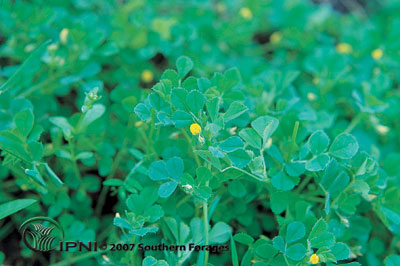
Subterranean Clover (Trifolium subterraneum)
Origin: Mediterranean region.
Description: Dense low-growing winter annual clover with hairy leaves. Small, mainly white flowers form a small bur which is forced into the surface of the soil. Good reseeding possible. Seed are large and either black or tan.
Major Uses: Pasture. Lower-yielding than crimson or arrowleaf.
Establishment: Seed are broadcast at 10 to 20 lb/A. Special inoculant required.
Fertilization: Fairly acid tolerant. Requires adequate phosphorus and potassium for growth.
Production: November-December and March-May.
Management: Tolerates close continuous stocking, and shade better than most clovers.
© Southern Forages. International Plant Nutrition Institute.
Cool-Season Perennial Legumes
These Legumes make most of their growth in the winter and Spring. Although these species are termed cool-season, many continue to be productive throughout the summer. Periods of drought will reduce growth. These species also provide good, high-protein pasture.
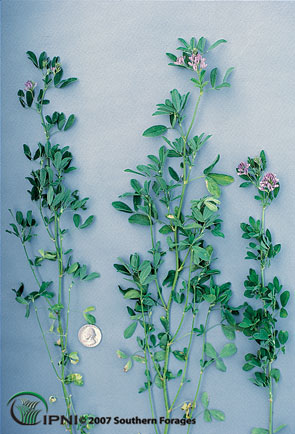
Alfalfa (Medicago sativa)
Origin: Iran and Central Asia.
Description: Dense Perennial. Erect-growing with many leafy stems arising from large crowns at the soil surface. Grows 24 to 36 inches tall. Compound leaves with three leaflets. Flowers of the varieties grown in the South are normally some shade of purple. Drought-tolerant, long taproot.
Major Uses: Hay and haylage, but has potential for expanded pasture use. Good alfalfa hay has high nutritive value and is in high demand, particularly for horses and dairy cattle.
Establishment: Seed. A seeding rate of 15 to 20 lb/A should be used. A cultipacker-seeder is the best planting equipment for prepared seedbeds. A firm seedbed is critically important. For sodseeding, a no-till drill is needed. Fall plantings should be made in conventional seedbed before September 15. Later plantings run greater risk of sclerotinia crown and stem rot damage. Spring plantings can be made March through May.
Fertilization: Alfalfa is sensitive to soil acidity, so pH values 6.5 or above are required for high yields. Where subsoils are very acid and high in aluminum, it may be possible to offset the toxic subsoil syndrome and promote deeper root development through deep incorporation of lime or the application of gypsum at a rate of about 2 ton/A. Potassium, phosphorus, sulfur and boron are the nutrients which usually need to be applied in order to obtain good alfalfa production. Alfalfa requires large amounts of potassium. Annual soil tests are critical in monitoring soil nutrient levels for this crop. Nitrogen fertilization is not needed, since alfalfa fixes large amounts of nitrogen if properly nodulated.
Production: April-October. Alfalfa has the longest productive season of any Southern-adapted legume.
Management: Successful alfalfa production requires a higher level of management than other forage crops. For hay production, 4 to 7 cuttings can be made each year depending on location. Harvesting at the early bloom stage is the best compromise for obtaining acceptable forage and nutrient yields with good stand persistence. Stand life is often 3 to 5 years, but alfalfa may persist for up to 8 years if adequately fertilized and cut at the proper stage of growth.
© Southern Forages. International Plant Nutrition Institute.
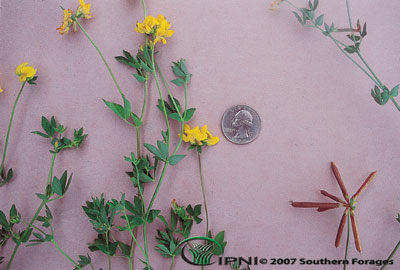
Birdsfoot Trefoil (Lotus corniculatus)
Origin: Mediterranean region.
Description: Deep-rooted, short-lived perennial, having finer stems and more leaves than alfalfa. Grows 12 to 30 inches tall, depending on whether it is a prostrate or erect variety. Flowers are bright yellow and the brown to purple seed pods radiate from the stem branch, resembling a bird’s foot. Non-bloating legume. Reseeds under proper management.
Major Uses: Pasture, erosion control. High quality forage.
Establishment: Seed are planted at 4 to 6 lb/A with cool season perennial grasses using a cultipacker-seeder in late August-September.
Fertilization: Lime if soil pH is below 5.5. Responds well to phosphorus and potassium.
Production: April-early October.
Management: Practical grazing management should leave 3 to 4 inches of leaf tissue to maintain root carbohydrates and assure vigorous regrowth. Since natural reseeding is essential for maintaining stands and productivity, plants should be allowed to produce some seed each year.
© Southern Forages. International Plant Nutrition Institute.
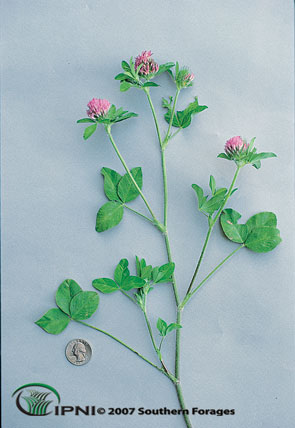
Red Clover (Trifolium pratenese)
Origin: Southeastern Europe and Turkey
Description: Short-lived perennial, usually 2 years in the South, but may survive only as an annual in Gulfcoast. Erect-growing, leafy plants 2 to 3 feet tall. Leaves hairy and marked with a white “V”. Flowers are clustered into large pinkish-violet heads.
Major Uses: Hay, pasture.
Establishment: Seed are planted on prepared land at 6 to 8 lb/A in drill rows or 12 to 15 lb/A broadcast during September-October and February-March in middle and northern U.S.. Established grass pastures should be overseeded in October-November or February-March. Seedling vigor is better than any other clover and especially well suited for seeding into cool season perennial grass sods.
Fertilization: If soil pH is below 5.5, lime should be applied. Responsive to phosphorus and potassium.
Production: March-June/July.
Management: Hay should be cut in early bloom stage. Red clover will provide more grazing than ladino clover during summer. Unlike ladino clover, red clover will not tolerate continuous close grazing over long periods of time.
© Southern Forages. International Plant Nutrition Institute.
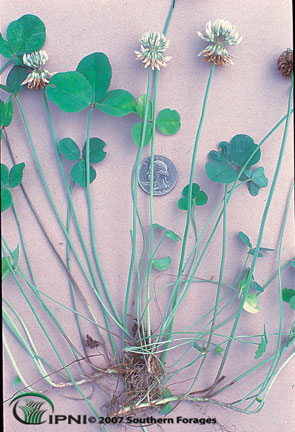
Ladino White Clover (Trifolium repens)
Origin: Mediterranean region.
Description: Fairly long-lived perennial in upper South; short-lived perennial or annual in lower South. Very leafy plants 8 to 12 inches tall that spread by stolons (runners) and form shallow roots at nodes. Leaves are non-hairy and usually marked with a white “V”. White flowers are clustered into heads. Seed are extremely small. Intermediate types of white clover can be expected to reseed naturally while giant or ladino types usually do not reseed well in the lower South.
Major Uses: Pasture. Very high quality grazing plant. Bloat can be a problem.
Establishment: Established grass pastures can be overseeded in February-March.
Fertilization: Soil should be limed if pH is below 6. Highly responsive to potassium fertilizer.
Production: March-June and October-November if soil moisture is favorable.
Management: Grass competition from undergrazing is one of the major problems in maintaining productive stands of white clover. Adequate potassium and phosphorus are important for good production. Grazing should be sufficient to maintain forage height at 1 to 4 inches, preventing shading of clover by the grass.
© Southern Forages. International Plant Nutrition Institute.
Warm-Season Annual Legumes
The Legumes provide good quality forage and fix nitrogen over an extended portion of the year. These species will often naturally reseed themselves and can be an important, high-quality component of summer pastures. The lespedezas are high in tannin and may help reduce parasite loads.
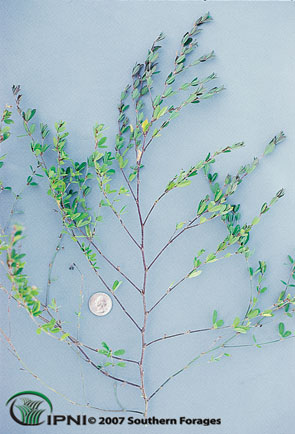
Annual Lespedeza (Kummerowia striata)
Origin: Eastern China, Korea, Japan.
Description: Annuals. Both species are fine-stemmed, leafy and have shallow taproots. Leaflets of Kobe are narrower than Korean. Seed of Kobe are in leaf axils while seed of Korean are borne in clusters at tips of branches. Reseed easily.
Major Uses: Pasture, hay, erosion control. High nutritive quality, furnishing excellent quality pasture in late summer. Relatively low yield.
Establishment: Seed are planted at 25 to 35 lb/A in February-March.
Fertilization: Tolerant of acidity and low soil phosphorus. Under high fertility, annual lespedezas are often crowded out by more vigorous and higher yielding grasses and legumes.
Production: July-September.
Management: High fertilization of a grass/lespedeza mixture reduces potential growth of lespedeza. Light grazing will allow some seed production for natural reseeding. Hay should be cut at early bloom stage.
© Southern Forages. International Plant Nutrition Institute
Warm-Season Perennial Legumes
The Legumes provide good quality forage and fix nitrogen over an extended portion of the year. These plants can provide a highly digestible, high-protein diet. The ability of these plants to fix atmospheric nitrogen makes them an inexpensive protein source. Warm-season legumes initiate growth in late spring after soil temperatures reach 65°F. Many of these species contain high levels of tannins, which can help reduce parasite loads.
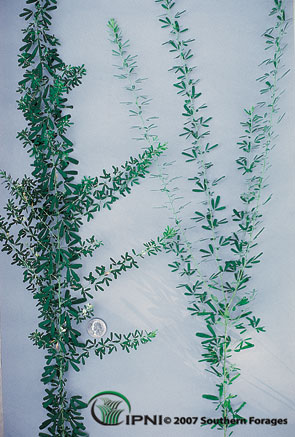
Sericea Lespedeza (Lespedeza cuneata)
Origin: Eastern China, Korea, Japan
Description: Perennial. Erect-growing, leafy, with fine stems in improved varieties. Grows 18 to 40 inches tall. Deep-rooted and drought tolerant. Small flowers. Non-bloating legume.
Major Uses: Hay, erosion control, pasture. Most varieties have high levels of tannin which reduce digestibility, but low-tannin varieties are available.
Establishment: Ideally, seed are planted at 20 to 30 lb/A with a preplant herbicide during late March-May. Establishment is often slow. Post-emergence herbicide treatment(s) may also be required.
Fertilization: Very tolerant of low fertility and acid soils; may respond to potassium on some soils.
Production: April to September.
Management: Hay harvests which leave a 4-inch stubble height should be made when plants are 15 to 24 inches tall, obtaining 2 to 3 cuttings per year. High-tannin sericea forage has nutritive value similar to bermudagrass; low-tannin types have superior nutritive value. When cut for hay, the tannin level of forage drops sharply, improving palatability and digestibility. Vigor and yield of low tannin sericea tend to be somewhat less than for high-tannin types. Grazing of sericea should begin when plants are 8 to 10 inches tall, and they should not be grazed lower than 4 inches. Removal of forage by grazing or hay production between late August or early September and the first killing frost should be avoided, as this is a period when food reserves are building in the roots. Tall fescue or orchardgrass can be overseeded on sericea to provide a longer productive season than sericea alone. Winter annuals such as cereals, crimson clover, or vetch can also be drilled into sericea in October to provide late winter forage. Grasses overseeded on sericea should be fertilized with nitrogen. © Southern Forages. International Plant Nutrition Institute
